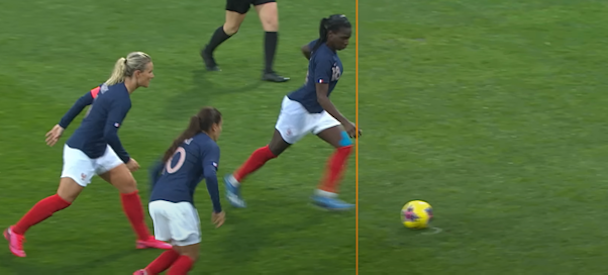The Orange Women’s World Cup ad is dividing the internet – which side are you on?
An ad from Orange for the Fifa Women’s World Cup has gone super-viral, with a twist that’s proving divisive. M&C Saatchi Sport & Entertainment’s Jenny Mitton investigates both camps of opinion.

The viral Orange Women's World Cup ad: which side are you on? / Credit: Orange / Marcel
You’d assume the most talked about Women’s World Cup ad would be the star-studded, high-value Nike film that launched earlier this week.
But no. Orange, the sponsor of France's team, caused a viral sensation on the internet with its ad, thanks to its surprising and unexpected twist.
The ad opens with a fast-paced sequence of clips showcasing the men's team scoring goals. However, as the footage rewinds, the VFX editing process unveils a surprising twist: the skills and goals actually belong to France's women's players.
The film has polarized the internet, causing the same levels of debate we saw around that ‘blue or gold’ dress. Two clear sides have emerged.
One group thinks that the ad is a game changer that will help change the perception of the quality of women’s football.
The other is frustrated that women’s football is still having to rely on the men’s game to prove its worth and attract attention.
Not even the media can keep up with the changing mood around the ad. The Daily Mail initially launched a story about the ad with the headline “Women’s World Cup TV advert which fooled viewers into believing they were watching Kylian Mbappe – before revealing the skills were performed by FEMALE players – is hailed as ‘brilliant’.”
Within hours, as the sentiment around the ad began to change, editors quickly changed the copy to: “World Cup TV advert fooling fans into believing Kylian Mbappe is playing when its actually the women’s team divides fans – as critics argue ‘lazy’ ad ‘uses men to highlight success”.
Advertisement
Which side are you on?
For me, the most interesting point is that the ad is targeting existing fans of the men’s game. Recent research from the Women’s Sport Trust identified men’s sports fans as the next big audience growth opportunity for the women’s game. Over 25 million people, or 40% of the UK population, watch men’s football in the UK. That’s a huge market share going largely untapped.
While brands and rights holders have rightly been focusing efforts on growing the new audiences coming into women’s football (the majority of which are new to football overall), clearly there’s a need to develop different communications tailored to address the distinct preferences of these two audiences.
We’ve seen this split across the leading Women’s World Cup ads. Nike and Lego have created films that focus on the skill, entertainment, and star power of the players, while Orange and Bud (with the help of a certain Argentine) have used the men’s game as a hook to draw in the audience.
Neither route is right or wrong; they both work for the audiences they are targeting.
It’s hugely encouraging to see brands engage different audiences around the women’s game. It clearly demonstrates that we’re moving beyond the perception that women’s sport is only for women. Moreover, it showcases the significant progress made, with multiple brands investing in above-the-line and targeting specific audiences, instead of a one-size-fits all approach. This will result in stronger creative.
Advertisement
Two games of two halves
At the heart of this debate is the fact that the women’s game is different from the men’s. We shouldn’t be afraid to recognize the women's game as a distinct product that offers unique opportunities and stands apart from the men's game.
Lewes football club chief executive Maggie Murphy commented on BBC Radio 4 this week that a lot of people see men’s football “as the pinnacle of success and that’s what women’s football should look like, but women’s football will never look like that because it is not men’s football. And there’s plenty of things women’s football does better or differently.”
Suggested newsletters for you
Using the men’s game to attract new fans to women’s football is a positive approach. The Orange film was created for the French market where women’s football isn’t as established as it is in England, so it made sense to use the men’s stars to draw in viewers. However, marketers must be cautious not to succumb to the trap of perpetuating stereotypes by claiming that the women’s game is identical to the men’s. It’s neither better nor worse, but simply a distinct and unique experience.
Before the 2019 World Cup, many of us lamented the lack of women's football ads. Now, the internet is abuzz with debates surrounding the women's World Cup ads. What a brilliant position to find ourselves in.
That said, I suspect I’m not alone in looking forward to the day we don't have to justify the quality of the women's game.
Until then, in England at least, we'll just have to bring it home. Again.
Content by The Drum Network member:

M&C Saatchi Group
We are a creative company with five specialist Divisions, connected through data, technology and culture, to deliver Meaningful Change for clients.
Find out more
